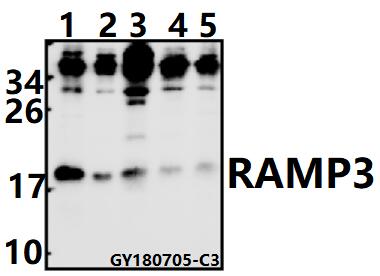Product Name :
RAMP3 polyclonal antibody Background :
Receptor activity-modifying proteins (RAMPs) are transmembrane accessory proteins that influence the pharmacological profiles of the calcitonin receptor-like receptors (CRLR). RAMPs associate with CRLR in the endoplasmic reticulum and facilitate the glycosylation and transport of CRLR to the cell surface, where the mature protein then operates as a receptor for two structurally related vasodilatory peptides, calcitonin-gene-related peptide (CGRP) or adrenomedullin (ADM). RAMP-1 associating with CRLR confers a CGRP receptor, while RAMP-2 and RAMP-3 preferentially induce a responsiveness to ADM. RAMP proteins, including RAMP-1, RAMP-2 and RAMP-3, are structurally similar as they are type I receptors, which have a single extracellular N-terminus and a cytoplasmic C-terminus, and they share approximately 55% sequence similarity. RAMP-1 expression is highest in the uterus, brain and gastrointestinal tract, whereas RAMP-2 and RAMP-3 are highest in lung, breast and fetal tissues. Product :
Rabbit IgG, 1mg/ml in PBS with 0.02% sodium azide, 50% glycerol, pH7.2 Storage&Stability :
Store at 4°C short term. Aliquot and store at -20°C long term. Avoid freeze-thaw cycles. Specificity :
RAMP3 pAb detects endogenous levels of RAMP3 protein. Immunogen :
Synthetic peptide, corresponding Human RAMP3. Conjugate :
Unconjugated Modification :
Unmodification
RAMP3 polyclonal antibody Background :
Receptor activity-modifying proteins (RAMPs) are transmembrane accessory proteins that influence the pharmacological profiles of the calcitonin receptor-like receptors (CRLR). RAMPs associate with CRLR in the endoplasmic reticulum and facilitate the glycosylation and transport of CRLR to the cell surface, where the mature protein then operates as a receptor for two structurally related vasodilatory peptides, calcitonin-gene-related peptide (CGRP) or adrenomedullin (ADM). RAMP-1 associating with CRLR confers a CGRP receptor, while RAMP-2 and RAMP-3 preferentially induce a responsiveness to ADM. RAMP proteins, including RAMP-1, RAMP-2 and RAMP-3, are structurally similar as they are type I receptors, which have a single extracellular N-terminus and a cytoplasmic C-terminus, and they share approximately 55% sequence similarity. RAMP-1 expression is highest in the uterus, brain and gastrointestinal tract, whereas RAMP-2 and RAMP-3 are highest in lung, breast and fetal tissues. Product :
Rabbit IgG, 1mg/ml in PBS with 0.02% sodium azide, 50% glycerol, pH7.2 Storage&Stability :
Store at 4°C short term. Aliquot and store at -20°C long term. Avoid freeze-thaw cycles. Specificity :
RAMP3 pAb detects endogenous levels of RAMP3 protein. Immunogen :
Synthetic peptide, corresponding Human RAMP3. Conjugate :
Unconjugated Modification :
Unmodification
-
 Western blot (WB) analysis of RAMP3 pAb at 1:500 dilution Lane1:H1792 whole cell lysate(20ug) Lane2:MCF-7 whole cell lysate(10ug) Lane3:Myla2059 whole cell lysate(40ug) Lane4:3T3-L1 whole cell lysate(40ug) Lane5:PMVEC whole cell lysate(40ug)
Western blot (WB) analysis of RAMP3 pAb at 1:500 dilution Lane1:H1792 whole cell lysate(20ug) Lane2:MCF-7 whole cell lysate(10ug) Lane3:Myla2059 whole cell lysate(40ug) Lane4:3T3-L1 whole cell lysate(40ug) Lane5:PMVEC whole cell lysate(40ug)
Bioworld Biotech only provide peptides for our antibodies and do not provide additional peptide customization services.
Price/Size :
USD 368/1mg/vial
Tips:
For phospho antibody, we provide phospho peptide(0.5mg) and non-phospho peptide(0.5mg).Describe :
Blocking peptides are peptides that bind specifically to the target antibody and block antibody binding. These peptide usually contains the epitope recognized by the antibody. Antibodies bound to the blocking peptide no longer bind to the epitope on the target protein. This mechanism is useful when non-specific binding is an issue, for example, in Western blotting (WB) and Immunohistochemistry (IHC). By comparing the staining from the blocked antibody versus the antibody alone, one can see which staining is specific; Specific binding will be absent from the western blot or IHC performed with the neutralized antibody.Formula:
Synthetic peptide was lyophilized with 100% acetonitrile and is supplied as a powder. Reconstitute with 0.1 ml DI water for a final concentration of 10 mg/ml.The purity is >90%,tested by HPLC and MS.
Storage:
The freeze-dried powder is more stable. For short time at 2-8°C. For long term storage store at -20°C.
Note :
This product is for research use only (RUO only). Not for use in diagnostic or therapeutic procedures.
 RAMP3 polyclonal antibody
RAMP3 polyclonal antibody  Datasheet
Datasheet COA
COA MSDS
MSDS SHIP
SHIP